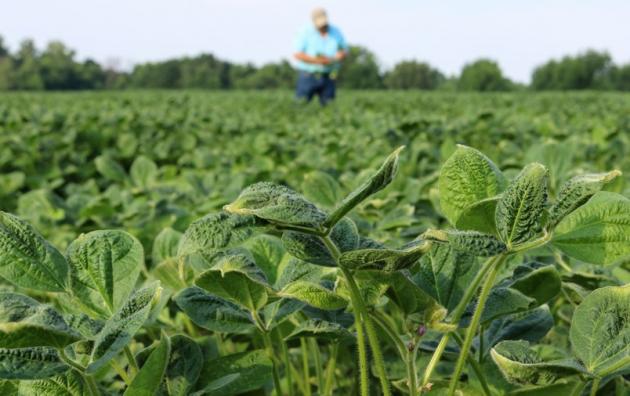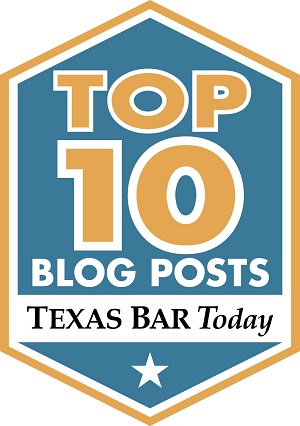Dicamba will likely go down as the biggest agricultural issue in 2017. This post will discuss some background information and then address several recent developments regarding the herbicide dicamba.

Photo by Chris Bennett, Farm Journal
Background
The herbicide dicamba has been in use since the 1960’s. In 2012, it was the 5th most used herbicide worldwide. The chemical, marketed under names including Clarity and Banvel, kills broadleaf weeds.
Things changed in the last few years when several agricultural businesses sought to alleviate concerns with weeds that had become resistant to the common herbicide glyphosate (the active ingredient in Roundup). Companies including Monsanto, BASF, and DowDupont developed genetically modified seeds for soybeans and cotton that possessed a dicamba tolerance. Thus, rather than applying glyphosate over the top of growing crops, farmers who planted these new seed varieties would be able to apply dicamba to growing crops that are tolerant to the chemical. This would allow farmers to combat the weeds that were resistant to glyphosate. In addition to these genetically modified seeds, the companies developed corresponding herbicides. For example, Monsanto touted its “cropping system” of dicamba-tolerant seeds called Xtendflex and XtendiMax herbicide containing the active ingredient dicamba. The new herbicide products were advertised as being less volatile and safer than prior formulations.
In 2015, Monsanto began selling its Xtendflex cotton seeds. In 2016, Monsanto’s Xtendflex soybean seeds were on the market. However, despite selling these seeds for the 2015 and 2016 crop years, the corresponding herbicide, XtendiMax, was not approved by the EPA for sale until November 2016. Other companies also developed herbicides to be used with the tolerant seeds. Dow received EPA approval for its Engenia product in December 2016 and DuPont’s FeXapan being approved in February 2017. At the time of approval, these herbicide products were approved for 2 year periods and were classified as general use pesticides–meaning that no pesticide applicator license or certification was required to purchase or apply.
In addition to receiving EPA approval and labeling under the Federal Insecticide, Fungicide, and Rodenticide Act (FIFRA), the products had to be approved for use in individual states as well. States can issue an approval or not, and can impose various additional requirements in addition to those included on the federally approved label. For example, in Arkansas, pesticide use is governed by the Plant Board. To date, the Monsanto XtendiMax product has never been approved for over-the-top crop use in Arkansas. The BASF Engenia herbicide was approved in 2017, but then in June, over-the-top dicamba use was banned by the Plant Board. In Texas, dicamba use was limited when it was listed as a “special use” and “regulated use” pesticide, unless it was to be applied in accordance with an approved label to transgenic auxin herbicide-tolerant crops, by ground, with wind speeds not exceeding 10 miles per hour.
Drift Complaints
Unfortunately, the rollout of these new crop systems was not as smooth as the companies would have hoped. Complaints of drift damage to neighboring fields began pouring in.
Even before the new dicamba formulations were approved for use, drift complaints were prominent across the South. In Tennessee, for example, there were approximately 40,000 acres destroyed by dicamba drift in 2016. Given that there was no dicamba formulation available for over-the-top application approved by the EPA during the 2016 growing season, it is likely that farmers who purchased the dicamba-tolerant seeds applied older, potentially more volatile versions of dicamba and applied them off-label to their crops.
These issues did not end when the new herbicides were available for use. The University of Missouri reports that drift damage from dicamba has been reported in 21 states. From January to September 2017, there were more than 963 alleged misuse complaints involving dicamba in Arkansas. At one point mid-growing season, drift complaints were so severe that Arkansas banned the further use of dicamba during the growing season. In June, Missouri initially imposed bans, but withdrew those in favor of imposing additional restrictions on application. Tennessee also imposed additional restirctions in June. The issue of drift damage is particularly concerning for sensitive crops such as soybeans, wine grapes, or vegetable produce.
According to Texas Farm Bureau, however, there have been only a handful of dicamba-related drift claims reported in 2016 and 2017.
Cause of Trouble
What is causing these drift issues remains to be seen. Certainly, a major difference between the new dicamba formulations versus the use of prior dicamba versions like Banvel or Clarity, is that the new products can be applied over the top of growing crops, not just at the pre-emergence stage. This means that if nothing else, there are more growing crops in neighboring fields and the sheer potential of damage to crops increases because more growing crops exist.
There are a number of possibilities that could be contributing to the drift damage from dicamba, and likely it may be a combination of any or all of them causing the problems:
- Failure to follow label requirements for the new formulations.
- Use of incorrect spray nozzles
- Improper boom height or operation speed
- Use of inappropriate tank mix partners, including acidifying agents
- Volitalization of new dicamba formulations despite following label instructions.
- Improper tank clean-out methods.
- Using older dicamba formulations (off-label) with the new seed varieties.
A recent BASF study in Arkansas shows that there were about 1.8 million acres of dicamba-tolerant seeds sold in Arkansas. There was only one dicamba-containing herbicide that was approved for over-the-top use in Arkansas, the BASF Engenia product. BASF reports that they sold only enough Engenia to be used on about 52% of the 1.8 million dicamba-tolerant acres. This shows, they claim, that there was wide-spread use of older formulations that were not approved for over-the-top application in Arkansas. Some attorneys in cases against BASF claim that the mid-season dicamba ban in Arkansas may have decreased sales and argue that some producers defensively planted the seeds, but sprayed no dicamba of their own. [Read article here.] The Missouri Department of Agriculture recently discussed the fact that determining whether damage was caused by the new herbicide products or by off-label application of the old products is extremely difficult. The agency has reached out to the EPA seeking guidance on whether it is possible to make that determination. [Read article here.]
EPA Label Modifications for 2018
In light of the numerous issues going on around the country, the Environmental Protection Agency released some amendments to the FIFRA-approved labels for XtendiMax, Engenia, and FeXapan in 2018. The three manufacturers–Monsanto, BASF, and DowDupont, voluntarily agreed to the additional requirements for their products. The changes include:
- These three products are now deemed “restricted use” under federal law, meaning that only certified applicators will be allowed to purchase an apply the products.
- Dicamba-specific training will be required for anyone seeking to purchase and apply these products.
- Increased recordkeeping requirements for applicators, including keeping “receipts of purchase” for these dicamba products for 2 years.
- Applications may only be made between sunrise and sunset.
- The application may only occur when wind speeds are between 3-10 miles per hour. (Previously, the federal label allowed application up to 15 mph, but Texas had already limited wind speed to 10 mph for dicamba).
- New tank cleanout language is included on the label to prevent cross-contamination.
- New language regarding sensitive crops and sensitive crop registries is included.
- Annual certification training for all those applying the new dicamba formulations.
This label will expire in December 2018 and supersedes all prior labels for these products.
Stay tuned for Part II next week, which will discuss some the pending litigation relating to dicamba.











